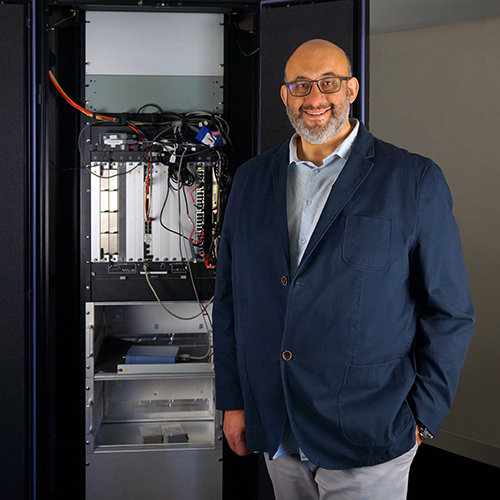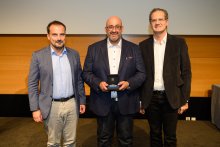The CNRS Crystal Medal awarded to Fatih Bellachia, software engineering expert at LAPP
On Monday 14 November, Fatih Bellachia was awarded the CNRS Crystal Medal. This medal is handed out to engineers, technicians, and administrative staff whose creativity, expertise, and sense of innovation have contributed, alongside researchers, to the advancement of knowledge and the excellence of French research.
A strong commitment to the ambitious projects of LAPP
Fatih Bellachia is a software engineering expert at LAPP and project manager for the ATLAS experiment at the Large Hadron Collider (LHC) at CERN in Geneva.

Fatih Bellachia joined the laboratory in 1992 as an assistant engineer, working in the experimental support team in the field of online data acquisition systems in the IT department. His excellence allowed him to progress in rank during his career, becoming a design engineer and then a research engineer.
With a degree in industrial computing, he is an expert in data acquisition systems within the two most important international project teams of the LAPP, and is considered as the technical referent of the “software engineering” team. His remarkable skills and knowledge have allowed the emergence of innovations that are always at the service of the laboratory’s projects and activities. After having contributed, for ten years, to the Virgo experiment for the detection of gravitational waves, and then, for eighteen years, to the implementation of the liquid argon calorimeter of the Atlas detector, which led to the discovery of the Higgs boson in 2012, he is now dedicated to an acquisition system that will allow the collection of 15 times more data, when the new version of the LHC comes into operation in 2029.
From the detection of gravitational waves with VIRGO to the discovery of the Higgs Boson with ATLAS
During his first years at LAPP, Fatih Bellachia was in charge of designing, building and deploying the first data acquisition and signal synchronisation systems for the VIRGO interferometer, a two-armed three-kilometre interferometer located in Italy. To this end, he was in charge of the software needed to implement, operate and test the electronic cards designed at LAPP.

In 2003, he changed his scientific focus to join the world of particle physics exploration on the future ATLAS detector at the Large Hadron Collider at CERN, one of the main projects of the laboratory. His technical expertise in the lowest layers of computer systems opened the doors to the international LArgOnline collaboration. In this context, he is also involved in the design, implementation and commissioning of a new acquisition system of unprecedented performance (2 petabytes/year of data) and complexity (more than 180,000 reading channels). This system is at the heart of the operation of the ATLAS liquid argon calorimeter (LAr): it allows the sorting of the physical events measured, in real time and at high frequency (1 kHz).
In order to carry out this project, Fatih Bellachia already relies on a consistent technological watch in computer science, which he carries out in addition to his professional activities. He then proposes software architectures that allow him to push back the generally accepted limits of the languages he implements, but always to the benefit of the project. After numerous on-site missions, the fruit of his work was officially commissioned in 2008. It will be crowned in 2012 by the discovery of the Higgs boson, made possible in particular thanks to the great reliability and high availability of the systems under Fatih Bellachia’s responsibility. These systems will have made it possible to accumulate enough data in the allotted time, in particular in the two-photon decay channel, to unequivocally validate the theory put forward in 1964 explaining the mass of any particle.
Fatih Bellachia then supervised and governed the developments of some twenty international contributors to the collaboration. In 2013, he officially took on the role of LArgOnline project manager, and supervises two full-time engineers at LAPP.

Towards the next evolution for ATLAS: the Phase-1 upgrade for the Run-3
In 2027, CERN will start operating a new version of its large collider, the HL-LHC. ATLAS will then have to process 15 times more data, calling into question almost its entire acquisition system. In 2013, Fatih Bellachia took on an additional responsibility, one that cuts across several CERN collaborations: the development of a key element of any ATCA system, the IPMC. He has developed the open-source ICARE project, which aims to design and build the firmware that starts up, manages and supervises each card in an ATCA chassis. It is a colossal task to analyse and then implement the international IPMI standard (more than 1500 pages of technical specifications) in a completely new embedded and buried environment, which is extremely restrictive and difficult to control: each interaction involves numerous third-party components, and the reproducibility of test conditions is therefore almost impossible. The IPMC cards and associated code have been successfully developed and are currently being installed and put into production in order to be ready for the start of the next CERN LHC Run-3 measurement campaign in 2021. Over the years, Fatih Bellachia has become the official technical expert on these crucial technologies in the collaboration.
For the past year, Fatih Bellachia has been opening up to new technical horizons within IN2P3’s transverse R&D team THINK. He is exploring the burying of artificial intelligence and neural networks deep in the detectors, by studying new types of processors that are currently appearing: neuromorphic chips. These technologies will be essential, for example, to achieve the exceptional performance required for the feasibility of future particle colliders in the second half of the 21st century, such as the FCC 100 km accelerator project at CERN.
Learn more:
- About Fatih Bellachia: https://www.alpes.cnrs.fr/fr/person…
- The CNRS Alpes 2022 medal ceremony: https://www.alpes.cnrs.fr/fr/cnrsin…
Cover picture : © Alexandre Gelin / CNRS. Centre: Fatih Bellachia. Left: Laurent Vacavant (DAS Particules et hadronique IN2P3). Right: Giovanni Lamanna (director of LAPP)


